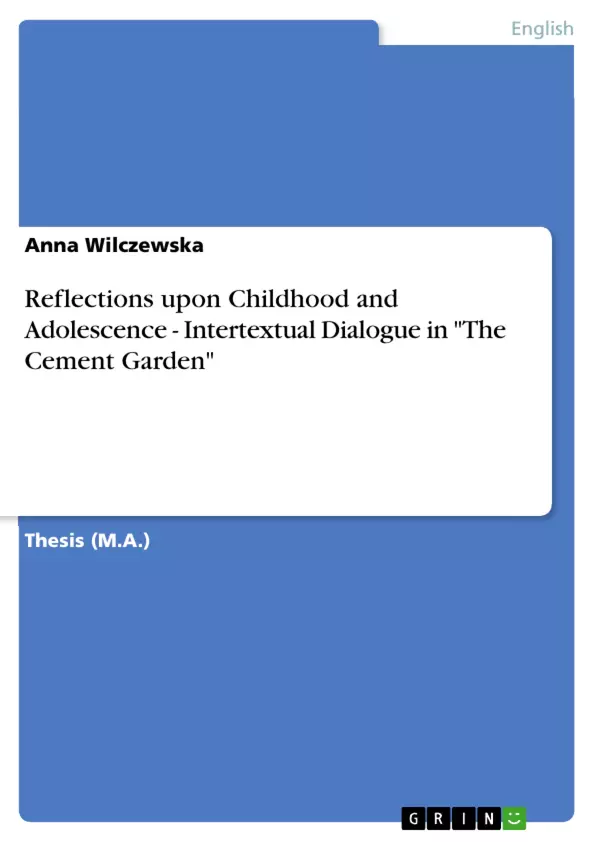Within the full spectrum of various literary theories offered by modern criticism,
the theory of intertextuality deserves a particular attention. This ambitious concept,
proposed by Julia Kristeva in the 1960’s, shed new light on the understanding and
approach to a literary text. Influenced by Bakhtin’s theory of dialogism, the French
scholar suggested a new model of communication which consists of two axes:
horizontal, involving communication between subject and addressee, and vertical which
is in an interaction between a text and a context. The two axes, as she claimed, coincide
which stresses the fact that “each word (text) is an intersection of word (texts) where at
least one other word (text) can be read” (Kristeva in: Allen: 2000, 39). She further drew
a conclusion that “any text is constructed like a mosaic of quotations; any text is the
absorption and transformation of another” (Kristeva in: Allen: 2000, 39). Consequently,
we can assume that any literary text does not exist on its own, but is rather in various
ways linked with other literary texts.
Barthes further develops Kristeva’s original concept and states that:
[…] a text is […] a multidimensional space in which a variety of writings, none of them
original, blend and clash. Text is a tissue of quotations drawn from innumerable
centuries of culture […] (Barthes in Allen: 2000, 13).
The text exists only in respect to other, prior literary texts, called intertexts, with which
the new text enters into a discourse. Literary plots, genres, stylistic devices, different
cultural symbols and images, methods of narration and many other aspects of a literary
work already existing in the literary tradition become a part of new text. (Allen: 2000,11) In this way a new literary text is always enriched by its intertexts which
complement the new text and shape its meaning. Intertextuality, thus, can be understood
as a study of those aspects of a literary work which indicate a great dependence of both
creation and reception of a given text on the whole network of the literary tradition
(Nycz: 1995, 62 ).
Another important facet of the theory of intertextuality is strictly connected with
an active role of the reader. As “the act of reading plunges us into a network of textual
relations” (Allen: 2000, 1), a considerable competence of the reader is required. In order
to grasp a full potential of the text, the readers should be aware of the rich literary
discourse which takes place in the text. [...]
Inhaltsverzeichnis (Table of Contents)
- INTORDUCTION
- CHAPTER 1: Modern Castaways
- CHAPTER 2: Terror of degeneration: Gothic markers in The Cement Garden
- CHAPTER 3: Parody of a Bildungsroman
- CONCLUSIONS
- BIBLIOGRAPHY
- STRESZCZENIE W JĘZYKU POLSKIM
Zielsetzung und Themenschwerpunkte (Objectives and Key Themes)
This MA thesis explores the concept of intertextuality, specifically examining its application within the novel "The Cement Garden" by Ian McEwan. The work aims to demonstrate how intertextuality enriches the narrative, shaping its meaning and offering insights into the text's themes and characters.
- The role of intertextuality in shaping the narrative of "The Cement Garden"
- Exploration of themes related to childhood, adolescence, and loss
- Analysis of gothic elements and their influence on the novel's atmosphere
- Examination of the novel's relationship to the Bildungsroman genre
- The reader's role in understanding the intertextual dialogue within the text
Zusammenfassung der Kapitel (Chapter Summaries)
The first chapter, "Modern Castaways," delves into the concept of intertextuality, highlighting its importance in understanding literary works. The chapter explores key concepts proposed by scholars such as Julia Kristeva and Roland Barthes, emphasizing the influence of prior texts and the active role of the reader in deciphering intertextual relationships. The chapter concludes by connecting these theoretical frameworks to the novel "The Cement Garden," suggesting its engagement with literary and cultural traditions.
Chapter two, "Terror of degeneration: Gothic markers in The Cement Garden," explores the gothic elements present in McEwan's novel, arguing that they contribute significantly to the atmosphere and thematic development. The chapter analyzes specific aspects of the gothic tradition present in the novel, highlighting their influence on the reader's experience.
Chapter three, "Parody of a Bildungsroman," delves into the novel's relationship with the Bildungsroman genre. It examines how McEwan subverts traditional elements of the Bildungsroman, offering a unique perspective on the themes of growth and development within the context of a dysfunctional family.
Schlüsselwörter (Keywords)
The key concepts explored in this thesis include intertextuality, gothic literature, Bildungsroman, childhood, adolescence, loss, family dynamics, and Ian McEwan's "The Cement Garden."
- Quote paper
- Anna Wilczewska (Author), 2011, Reflections upon Childhood and Adolescence - Intertextual Dialogue in "The Cement Garden", Munich, GRIN Verlag, https://www.grin.com/document/211607



